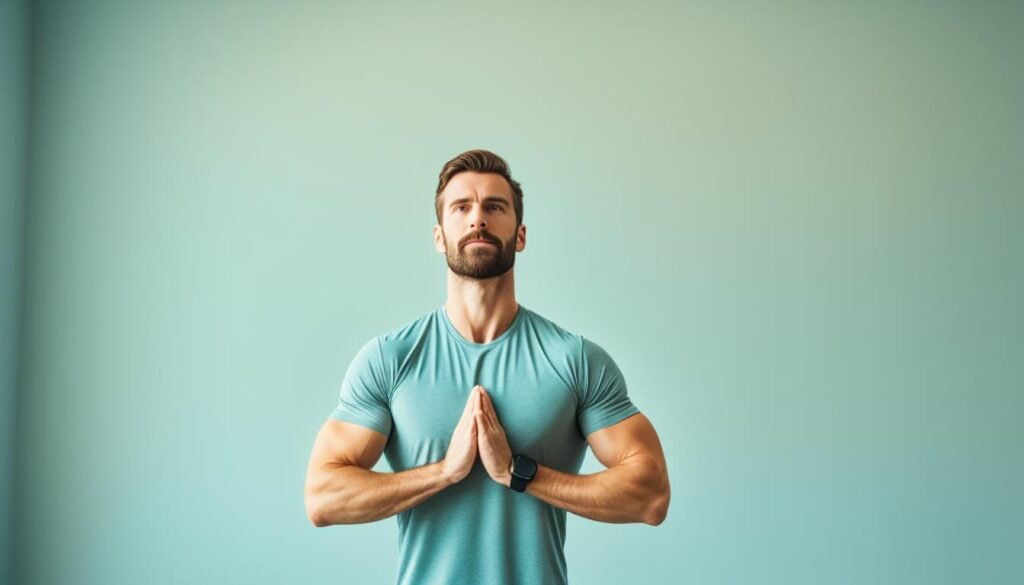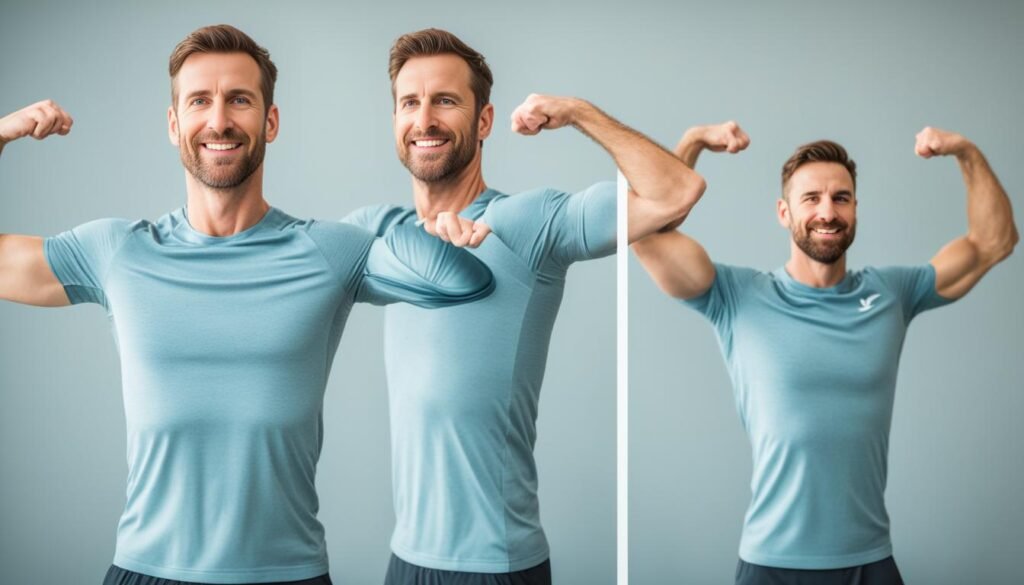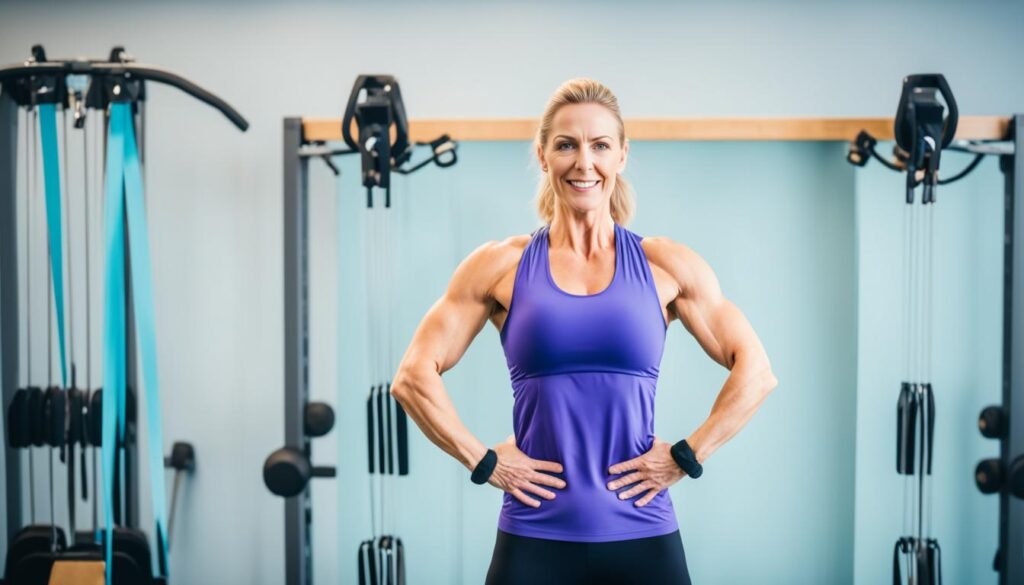Achieving and maintaining good posture can be a game-changer for your physical and mental well-being. By incorporating a blend of exercises for better posture, posture exercises, and strategic stretches, you can unlock a world of benefits, from reduced muscle pain and improved flexibility to enhanced balance and potential mental health advantages.
The foundation of good posture lies in strengthening the core, shoulders, and back muscles. Regular practice of exercises to improve posture, such as good posture workouts and posture stretches, can help realign your spine, alleviate tension in the back, shoulders, and neck, and promote overall bodily harmony. These ergonomic exercises can be seamlessly integrated into your daily routine, empowering you to take charge of your physical well-being.
Beyond the physical benefits, research suggests that proper posture can have a positive impact on mental health. A 2017 study found that upright posture can help increase positive affect, decrease negative self-focus, and reduce fatigue in individuals with mild-to-moderate depression. Additionally, a 2018 study revealed that adopting an expansive posture may improve body-related emotions, including body image satisfaction and self-appraisal.
The Importance of Good Posture
Proper posture exercises and maintaining good posture are essential for overall physical and mental well-being. When you practice exercises for better posture and develop a strong, aligned stance, you can experience a range of benefits that extend far beyond mere aesthetics.
Reduced Muscle Pain and Fatigue
Good posture workouts and maintaining correct body alignment can help alleviate muscle pain and fatigue throughout the day. By distributing weight evenly and reducing stress on your muscles and ligaments, you can experience increased energy levels and a greater sense of overall comfort.
Improved Flexibility and Balance
Posture stretches and targeted back exercises for posture can enhance your flexibility and balance, allowing you to move with greater ease and stability. This improved mobility can translate to better performance in sports, fitness activities, and everyday tasks.
Lower Risk of Injury
When you prioritize shoulder posture exercises and maintain proper neck posture exercises, you reduce the strain on your body, which can lower your risk of injuries, such as muscle strains, joint pain, and even chronic conditions like back pain.
Potential Mental Health Benefits
Interestingly, research suggests that good posture may also have positive effects on mental well-being. A 2017 study found that upright posture can help increase positive affect, decrease negative self-focus, and reduce fatigue in people with mild-to-moderate depression. Additionally, a 2018 study discovered that adopting an expansive posture can improve body-related emotions, including body image satisfaction and self-appraisal.
Child’s Pose
Child’s pose is a soothing and restorative posture that can help stretch and lengthen your spine, glutes, and hamstrings. It may also release tension in your lower back and neck, making it an excellent choice for improving your overall posture.
Stretches the Spine, Glutes, and Hamstrings
To perform this pose, sit on your shins with your knees together and your big toes touching. Slowly fold forward at the hips, walking your hands out in front of you and sinking your hips back toward your heels. Gently place your forehead on the floor or turn your head to one side. Keep your arms extended or resting alongside your body. Breathe deeply into the back of your rib cage and waist as you relax in this position for up to 5 minutes.
Releases Tension in Lower Back and Neck
The forward fold and grounded positioning of Child’s pose helps release any built-up tension or tightness in your lower back and neck area. This can improve mobility and alleviate discomfort associated with poor posture exercises or prolonged sitting. By sinking your hips back and allowing your spine to lengthen, you’ll experience a therapeutic stretch throughout your entire back and posterior chain.
Forward Fold
This standing stretch releases tension in your spine, glutes, and hamstrings. It also stretches your hips and legs. To do this pose, stand with your big toes touching and your heels slightly apart. Bring your hands to your hips and fold forward at your hips. Release your hands toward the floor or place them on a block. Bend your knees slightly, soften your hips, and allow your spine to lengthen. Tuck your chin into your chest and allow your head to fall heavy to the floor. Remain in this pose for up to 1 minute.
Releases Tension in Spine, Glutes, and Hamstrings
Stretches Hips and Legs
Cat-Cow Pose
Cat-Cow pose helps relieve tension in your torso, shoulders, and neck while promoting blood circulation and spinal mobility. This gentle flow engages the core muscles and increases flexibility throughout the spine.
Relieves Tension in Torso, Shoulders, and Neck
The alternating arching and rounding movements of the Cat-Cow pose help release built-up tightness in the upper back, shoulders, and neck area. This can be particularly beneficial for those who spend a lot of time hunched over computers or mobile devices.
Promotes Blood Circulation and Spinal Mobility
As you move through the poses, the flow encourages the spine to move through its full range of motion. This increased mobility and blood flow can help improve overall posture and reduce the risk of injury. The deep breathing used in the pose also promotes oxygenation throughout the body.
To perform the Cat-Cow pose, come onto your hands and knees with your weight evenly distributed. Inhale as you look up, dropping your abdomen toward the floor and extending your spine. Exhale, arching your back toward the ceiling and tucking your chin. Continue this movement for at least 1 minute, moving with your breath.
Standing Cat-Cow
A variation on the standard Cat-Cow, this standing posture helps loosen up tightness in your back, hips, and glutes. To do this pose, stand with your feet about hip-width apart with a slight bend in your knees. Extend your hands in front of you or place them on your thighs. Lengthen your neck, bring your chin toward your chest, and round your spine. Then look up, lift your chest, and move your spine in the opposite direction. Hold each position for 5 breaths at a time. Continue this movement for a few minutes.
Chest Opener
Opening and stretching your chest is especially useful if you spend most of your day sitting, which tends to make your chest move inward.
To do this stretch, stand with your feet about hip-width apart. Bring your arms behind you and interlace your fingers with your palms pressing together. Grasp a towel if your hands don’t reach each other. Inhale as you lift your chest toward the ceiling and bring your hands toward the floor. Breathe deeply as you hold this pose for 5 breaths. Release and relax for a few breaths. Repeat at least 10 times.
Stretches Chest Muscles
This posture helps open and stretch the chest muscles, which can become tight from prolonged sitting or poor posture.
Counters Effects of Prolonged Sitting
Performing this chest opener routine can help counteract the effects of prolonged sitting, which tends to make the chest muscles and shoulders move inward. Regularly practicing this stretch can help improve overall posture and mobility.

Exercises for Better Posture
Incorporating specific exercises into your routine can go a long way in improving your posture and supporting overall physical and mental well-being. From strengthening core muscles to stretching tight areas, these exercises target the key areas that play a crucial role in maintaining good posture.
High Plank
High planks help relieve pain and stiffness throughout your body while strengthening your shoulders, glutes, and hamstrings. They also help develop balance and strength in your core and back, both important for good posture. From a high plank position, straighten your back and engage your abdominal, arm, and leg muscles. Lengthen the back of your neck, soften your throat, and look down at the floor. Hold this position for up to 1 minute at a time.
Side Plank
Engaging in a Side Plank exercise for up to 30 seconds works the muscles in the sides and glutes, supporting the back and improving posture. To perform this exercise, lie on your side with your elbow directly under your shoulder. Engage your core and lift your hips off the floor, forming a straight line from your head to your feet.
Downward-Facing Dog
Practicing Downward-Facing Dog pose for up to 1 minute can help relieve back pain, strengthen and align the back muscles, promoting better posture. Start on your hands and knees, then press your palms into the floor and lift your hips up and back, creating an inverted V shape with your body. Lengthen your spine and engage your leg muscles to support the pose.
Pigeon Pose
This hip-opening posture can also loosen up your spine, hamstrings, and glutes. To do this pose, come down on all fours with your knees below your hips and your hands a little bit in front of your shoulders. Bend your right knee and place it behind your right wrist with your right foot angled out to the left. Rest the outside of your right shin on the floor. Slide your left leg back, straighten your knee, and rest your thigh on the floor. Slowly lower your torso down to rest on your inner right thigh with your arms extended in front of you. Hold this position for up to 1 minute. Slowly release the position by walking your hands back toward your hips and lifting your torso. Repeat on the opposite side.
Opens Hips and Stretches Hamstrings
This pose helps open your hips and stretch your hamstrings, two key areas for maintaining good posture. By lengthening these muscle groups, you can improve your overall spinal alignment and mobility.
Lengthens Spine and Glutes
In addition to the hip and leg benefits, the Pigeon Pose also helps lengthen your spine and activate your glute muscles. This can further enhance your body’s core stability and support better posture from top to bottom.
Thoracic Spine Rotation
Gently opening the chest and rotating the spine relieves tightness while increasing stability and mobility. To do this stretch, come onto all fours and sink your hips back down to your heels and rest on your shins. Place your right hand behind your head with your elbow extended to the side. Keep your left hand under your shoulder or bring it to center and rest on your forearm. Exhale as you rotate your right elbow up toward the ceiling and stretch the front of your torso. Take one long inhale and exhale in this position. Release back down to the original position. Repeat this movement 5–10 times, alternating sides.
Opens Chest and Rotates Spine
This exercise helps open the chest and gently rotate the spine, relieving any tightness or restrictions in these areas.
Increases Stability and Mobility
By focusing on controlled movements and proper alignment, this posture can help improve overall stability and mobility in the thoracic spine region.

Glute Bridge
The glute bridge is a powerful exercise that can help strengthen and activate your glutes while also relieving lower back pain. This posture-enhancing exercise can improve the alignment and functioning of your hips and pelvis, leading to better overall posture.
Strengthens and Activates Glutes
The bridge pose works the quads, glutes, low back, and transverse abdominis, which helps improve balance and stability in the pelvis and core. By focusing on engaging the glutes during this exercise, you can better target and strengthen this crucial muscle group.
Relieves Lower Back Pain
Many people struggle with lower back pain, often due to prolonged sitting or poor postural habits. The glute bridge can help alleviate this discomfort by targeting the underlying muscle imbalances and tension in the back and hips.
Improves Hip and Pelvic Alignment
Proper execution of the bridge pose, which involves engaging the core, keeping the knees in line with the hips, and maintaining good shoulder positioning, can positively impact the alignment and function of your hips and pelvis. This can translate to better overall posture and reduced strain on the lower back.
To perform the glute bridge exercise correctly, start by lying on your back with your knees bent and your feet about hip-distance apart. Rest your arms alongside your body with your palms facing down. Exhale as you lift your hips toward the sky, straightening your spine. Hold this position for up to 1 minute at a time, being mindful not to let your knees splay wider than your hips, which can affect stability. Regular practice of the glute bridge, combined with exercises like wall squats, pelvic tilts, chest openers, and leg lifts to the back, can help strengthen the glutes and core to improve overall posture and reduce the risk of injury.


